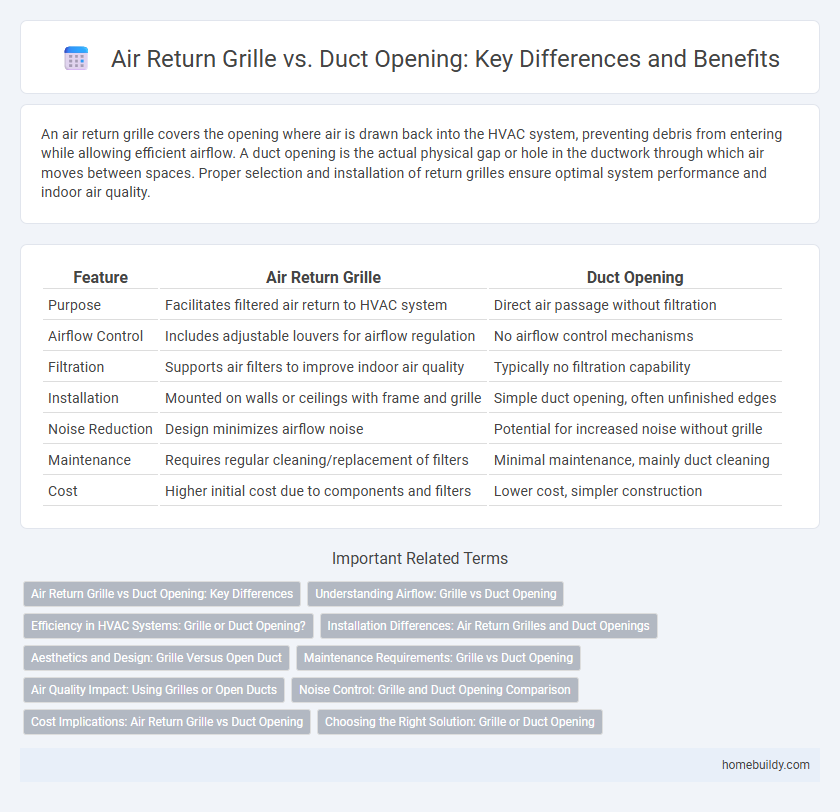An air return grille covers the opening where air is drawn back into the HVAC system, preventing debris from entering while allowing efficient airflow. A duct opening is the actual physical gap or hole in the ductwork through which air moves between spaces. Proper selection and installation of return grilles ensure optimal system performance and indoor air quality.
Table of Comparison
| Feature | Air Return Grille | Duct Opening |
|---|---|---|
| Purpose | Facilitates filtered air return to HVAC system | Direct air passage without filtration |
| Airflow Control | Includes adjustable louvers for airflow regulation | No airflow control mechanisms |
| Filtration | Supports air filters to improve indoor air quality | Typically no filtration capability |
| Installation | Mounted on walls or ceilings with frame and grille | Simple duct opening, often unfinished edges |
| Noise Reduction | Design minimizes airflow noise | Potential for increased noise without grille |
| Maintenance | Requires regular cleaning/replacement of filters | Minimal maintenance, mainly duct cleaning |
| Cost | Higher initial cost due to components and filters | Lower cost, simpler construction |
Air Return Grille vs Duct Opening: Key Differences
Air return grilles are designed to cover duct openings, allowing air to flow back into the HVAC system while preventing debris from entering, whereas duct openings are simply the raw entry points within the ductwork without any protective or aesthetic covering. Air return grilles often incorporate louvers or filters to improve air quality and reduce noise, contrasting with duct openings which are functional voids requiring finishing elements for proper operation. The key difference lies in their roles: air return grilles serve as functional access points and design elements, while duct openings are structural components of the ventilation system.
Understanding Airflow: Grille vs Duct Opening
Air return grilles regulate airflow by providing a controlled pathway for air to re-enter the HVAC system, while duct openings serve as direct, unfiltered entry points. Grilles incorporate louvers or perforations that help distribute air evenly and reduce noise, optimizing ventilation efficiency. Understanding the difference ensures proper system design, enhancing indoor air quality and energy performance.
Efficiency in HVAC Systems: Grille or Duct Opening?
Air return grilles enhance HVAC system efficiency by regulating airflow and filtering particulates, preventing debris from entering ductwork and ensuring consistent air circulation. In contrast, duct openings without grilles may allow unrestricted airflow but risk reduced system performance due to dust accumulation and uneven pressure distribution. Properly sized and installed air return grilles optimize energy use and indoor air quality, outperforming bare duct openings in maintaining balanced ventilation.
Installation Differences: Air Return Grilles and Duct Openings
Air return grilles require precise mounting on walls or ceilings to ensure efficient airflow filtration and aesthetic integration, while duct openings involve direct access points within HVAC systems for air circulation. Installation of air return grilles typically includes securing with screws and sealing edges to prevent leaks, contrasting with duct openings which often require additional duct connectors or collars for system compatibility. Proper alignment and sizing during air return grille installation optimize airflow efficiency, whereas duct openings focus on structural integration within the ductwork framework.
Aesthetics and Design: Grille Versus Open Duct
Air return grilles enhance aesthetics by providing a clean, finished look that conceals duct openings while allowing proper airflow. Unlike open ducts, grilles can complement interior design through various styles, sizes, and materials, adding to the room's visual appeal. Open duct openings often appear industrial and unfinished, lacking the versatility and decorative options that grilles offer.
Maintenance Requirements: Grille vs Duct Opening
Air return grilles require regular cleaning to prevent dust buildup and maintain airflow efficiency, whereas duct openings often demand less frequent attention but necessitate periodic inspection for debris and blockages. Grilles are easier to access and clean compared to duct openings, which may require professional services to ensure thorough maintenance and system performance. Proper upkeep of both components is essential to optimize HVAC efficiency and indoor air quality.
Air Quality Impact: Using Grilles or Open Ducts
Air return grilles improve indoor air quality by filtering and regulating airflow, reducing the entry of dust and contaminants compared to open duct openings. Open duct openings allow unfiltered air to circulate, increasing the risk of airborne pollutants and allergens spreading throughout the space. Effective use of return grilles supports HVAC efficiency while maintaining cleaner, healthier air in residential and commercial environments.
Noise Control: Grille and Duct Opening Comparison
Air return grilles incorporate built-in acoustic features such as sound-absorbing materials and baffle designs that significantly reduce noise transmission compared to standard duct openings. Unlike bare duct openings, grilles minimize air turbulence and mechanical noise by controlling airflow direction and velocity. Optimizing noise control in HVAC systems relies on upgrading from basic duct openings to engineered air return grilles that enhance acoustic comfort and overall system efficiency.
Cost Implications: Air Return Grille vs Duct Opening
Air return grilles typically cost less than duct openings because they require minimal labor and materials for installation, often just mounting over an existing opening. Duct openings involve higher expenses due to the need for precise sheet metal fabrication, sealing, and integration with HVAC ductwork. Choosing an air return grille can reduce upfront costs, but duct openings may provide better airflow efficiency, potentially impacting long-term energy expenses.
Choosing the Right Solution: Grille or Duct Opening
An air return grille provides a finished, aesthetic cover for duct openings while allowing efficient airflow back into the HVAC system, essential for maintaining proper ventilation and air circulation. In contrast, a simple duct opening lacks a protective grille and may reduce air filtration efficiency and increase debris entry, potentially affecting system performance. Selecting an air return grille over a bare duct opening enhances air quality, system longevity, and overall HVAC effectiveness in residential or commercial environments.
air return grille vs duct opening Infographic

 homebuildy.com
homebuildy.com